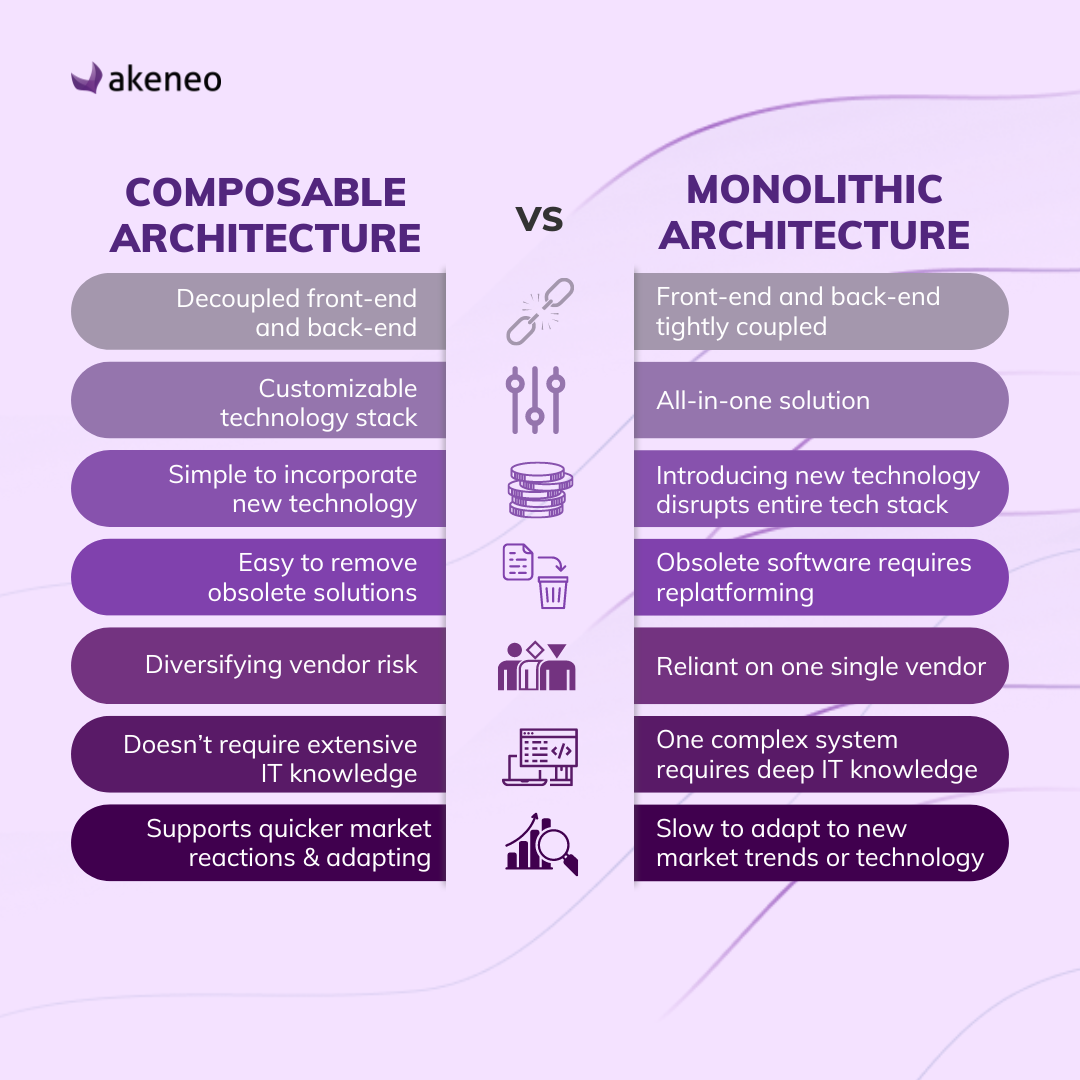Discover why future-thinking brands and retailers are making the move to composable commerce architecture, and how it can revolutionize your eCommerce offerings.

Table of Contents
Keywords
Whether it’s new digital marketplaces coming onto the scene, social media apps looking to break into eCommerce, or new technology like AI permeating the retail landscape, there seems to be an almost endless stream of new channels that many, if not all, brands and retailers are struggling to keep up with. Why?
Simply put, their eCommerce presence is precariously built on a traditional, monolithic commerce architecture that offers a single solution, from a single vendor, and a single digital experience.
And while this one-size-fits-all approach worked for many years to support standardized experiences and basic eCommerce offerings, the digital marketplace has expanded at such a rapid pace that we’ve quickly outgrown this legacy architecture. It wasn’t built to accommodate all the facets that are now required to produce high-quality product experiences across so many different channels.
Enter composable commerce; the modular approach to eCommerce that enables true omnichannel product experiences.
Composable commerce is a development approach that leverages best-of-breed vendors composed together into a singular, custom-built application. This type of architecture model allows teams to create an ecosystem that is customized to meet their organization’s specific business needs, enabling activation of their entire product record across every channel.
Instead of the traditional, monolithic approach, composable commerce software communicates via API, meaning each individual solution can be updated or replaced at any time without disrupting the rest of the system. This creates a flexible, scalable eCommerce stack that can easily be updated or adapted to meet your needs as your organization grows.
A traditional, monolithic approach offers an all-in-one solution from a single vendor, providing the basic capabilities needed to activate an eCommerce site.
For a while, this met a need in the market; everything was stored in the same place, and organizations had everything they needed to provide a singular, standard experience for all their customers.
However, thanks to the impact of both the pandemic and rapid technological innovation, the needs of modern organizations span much farther than the reach of traditional commerce architecture. There are new digital touchpoints emerging constantly that these legacy platforms simply weren’t built to accommodate, not to mention the ever-growing expectations of customers to have a dynamic, cohesive, and engaging experience with your product no matter where they discover or search for you.
At a more granular, technical level, massive monolithic code bases present steep roadblocks; plug-and-play replacements of outdated technology is impossible, extensive knowledge of the code base is required for developers to do any sort of adjustments, and scalability is severely limited. As a result, development speed and time-to-market is simply too slow to keep up with the speed of today’s economy.
As consumer behaviors continue to rapidly shift and digital touchpoints continue to expand, more and more organizations are beginning to move away from a traditional model and towards a composable commerce model that decouples the frontend user experience from the backend logistics. This offers organizations the flexibility to customize their tech stack to their specific business needs.
With composable commerce, brands are able to:

Composable commerce architecture has been growing in popularity as more and more organizations continue to search for a more scalable and flexible model. But what does that actually look like in practice? Let’s take a look at three of the defining features of this modern commerce architecture.
Arguably the most important aspect of composable commerce approach is its modular nature. Every component of your tech stack is replaceable, and therefore scalable. Changing, adding, or removing one aspect of your tech stack will no longer crumble your entire ecosystem like a fragile Jenga tower.
What does this mean? Accelerated time-to-market, increased eCommerce conversions, eliminated redundant technology costs, and stronger omnichannel customer experiences.
An open ecosystem essentially means that your organization isn’t tied to one specific vendor; you are free to select the software that best serves each individual business need, ensuring that you’re receiving world-class SaaS products across the board. This is a particularly useful aspect as it allows your team to easily swap out technology if a piece of software isn’t performing the way you intended it to, it’s been changed, or it becomes obsolete due to changed internal processes.
This open ecosystem also encourages simple integrations and deep customization capabilities, allowing your team to essentially build the perfect system for your commerce tech stack.
The scalability and flexibility of a composable commerce architecture is one of the biggest reasons so many organizations are beginning to transition. Whether it’s adapting to meet the needs of new customer markets, new global locations, new products, or new eCommerce channels, composable commerce offers the flexibility to meet your organization’s needs that a traditional approach can’t compete with.
So we've covered the basics of composable commerce, and how this architecture framework often provides greater agility and control to brands and retailers. But now let's dive into the specific benefits that an organization can reap from migrating to a composable commerce architecture.
Mobile, print, web, social media, retailer sites, even newer channels like voice search and TikTok. All of these existing touchpoints, and those of tomorrow, are potential places where your customers could discover you, but showing up on these channels requires a strong technological foundation to syndicate product information and listings. Monolithic architectures are often too rigid to adapt quickly to these rapid market changes.
Swap in and out components of your tech stack as needed, allowing your ecosystem to scale to meet your needs. Whether you need to replace an old piece of technology, incorporate a new software tool, or upgrade existing functionality and capacity, you can do so freely with this type of plug-and-play architecture.
By increasing internal operational efficiencies and leveraging modern technology stacks, your organization is able to save time and money. Plus, you’re customizing your tech stack to what works best for your team, so you aren’t paying for features or solutions you don’t use.
The user-friendly aspect of composable commerce means that managing and operating within this commerce approach doesn’t require in-depth technical skills from developers. Unlike the traditional model, composable commerce allows non-technical employees to perform necessary tasks.
More channels than ever before means more competition than ever before; the product experience that you offer to your customers needs to stack up or you risk losing their loyalty. By utilizing best-of-breed technologies and allowing your organization to scale, you’re able to provide your consumers with the personalized experience they’re looking for.
Future-proofing your business means that you need to be able to create compelling and consistent product experiences across all your owned and unowned channels, and that is significantly more simple when you've implemented a composable approach that allows you to plug-and-play technologies as you scale.
The inherently modular nature of the architecture, coupled with the flexibility and scalability it offers, means that a composable commerce approach is the one of the most efficient way brands and retailers can activate their product story across each and every channel, regardless of if it’s owned by them or not. By streamlining internal operations and relying on best-of-breed technology, composable commerce enables organizations to deliver unique, personalized product experiences to their consumers at every stage.
Interested in learning more about how to migrate to a composable commerce model? Request a demo of Akeneo today to see how our MACH-certified PIM can help.